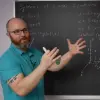

NARROW DISPLAY WARNING
You are most likely using a tablet or mobile device in portrait orientation. This website is best viewed using a typical computer screen with the browser window maximized.
Viewing this website in portrait orientation can cause problems with equations being longer than the screen width (you can scroll to the right), images being poorly sized, and the font size of maths text being much smaller than regular text. If your only option is a tablet or mobile device, your viewing experience will be better if you view this website in landscape orientation. You might need to refresh the page to fix any problems after rotating.
A lot of differential equations come from physics, and a lot of physics equations conserve a quantity. Common examples are conservation of energy, conservation of mass, and conservation of momentum. The equation for the conserved quantity can look like $F(x,y) = C$ where $x$ and $y$ are properties of the physical system, $F(x,y)$ calculates the total energy of the system for for given $x$ and $y$ state, and $C$ is the total energy of the system which never changes. An example is a frictionless pendulum. The inputs $x$ and $y$ could represent the velocity and height of the arm of the pendulum, $F(x,y)$ calculates the energy for a velocity and height, which must always equal the same amount of energy $C$.
When a derivative is applied to an equation that conserves a quantity, an exact equation results. There's a way to test if a differential equation is an exact equation. If the differential equation is an exact equation, then there's a way to work backwards to the $F(x,y)=C$ which solves the exact differential equation since there are no longer any derivatives of $y$ present. The procedure is a bit confusing though, so we'll go through some examples to understand the process. Partial derivatives are also used, but those will be explained as well.
Take the derivative with respect to $x$ on the following equation with $y=y(x)$ is a function of $x$.
\begin{equation} F(x,y) = 7x^{2}y^{3} + \sin(y) - e^{x} = C \end{equation} \begin{equation} \frac{\text{d}}{\text{d}x}F(x,y) = \frac{\text{d}}{\text{d}x} \big( 7x^{2}y^{3} + \sin(y) - e^{x} \big) = \frac{\text{d}}{\text{d}x} C \end{equation} \begin{equation} \frac{\text{d}}{\text{d}x}F(x,y) = 14xy^{3} + 21x^{2}y^{2}y' + \cos(y)y' - e^{x} = 0 \end{equation}This can also be written in terms of partial derivatives. The name of the $\partial$ symbol is partial. The partial derivative with respect to $x$ is written as $\displaystyle \frac{\partial}{\partial x}$, and the partial derivative with respect to $y$ is written as $\displaystyle \frac{\partial}{\partial y}$. Partial derivatives are part of multivariable calculus, but for exact equations all you need to know is $\displaystyle \frac{\partial}{\partial x}$ is like taking the derivative with respect to $x$ while treating $y$ as a constant and $\displaystyle \frac{\partial}{\partial y}$ is like taking the derivative with respect to $y$ while treating $x$ as a constant.
\begin{equation} \frac{\partial F}{\partial x} = 14xy^{3} - e^{x} \qquad\qquad \frac{\partial F}{\partial y} = 21x^{2}y^{2} + \cos(y) \end{equation} \begin{align} \frac{\text{d}}{\text{d}x}F(x,y) &= \frac{\partial F}{\partial x} + \frac{\partial F}{\partial y} y' \\ &= 14xy^{3} - e^{x} + \big( 21x^{2}y^{2} + \cos(y) \big) y' \end{align}Computing $\displaystyle \frac{\text{d}}{\text{d}x}F(x,y)$ the normal way and using partial derivatives are exactly the same. The result is some of the terms are multiplied by $y'$ and others are not. These are often named $M(x,y)$ and $N(x,y)$. (Warning: Be careful with your textbook as these names are not standardized.)
\begin{align} \frac{\text{d}}{\text{d}x}F(x,y) &= \frac{\partial F}{\partial x} + \frac{\partial F}{\partial y} y' \\ &= M(x,y) + N(x,y)y' \end{align} \begin{equation} M(x,y) = 14xy^{3} - e^{x} \qquad\qquad N(x,y) = 21x^{2}y^{2} + \cos(y) \end{equation}Partial derivatives can do strange things, but for this course you can always assume that the order of the partial derivatives doesn't matter.
\begin{equation} \frac{\partial }{\partial x}\frac{\partial }{\partial y}F = \frac{\partial^{2} F}{\partial x \partial y} = \frac{\partial^{2} F}{\partial y \partial x} = \frac{\partial }{\partial y}\frac{\partial }{\partial x}F \end{equation}Because the order of the partial derivatives doesn't matter, a way to test if a differential equation is and exact equation from a conservation law $F(x,y)$ is the following.
\begin{equation} \frac{\partial }{\partial x}\frac{\partial }{\partial y}F = \frac{\partial }{\partial x}N \qquad \qquad \frac{\partial }{\partial y}\frac{\partial }{\partial x}F = \frac{\partial }{\partial y}M \end{equation}If $\displaystyle \frac{\partial }{\partial x}N = \frac{\partial }{\partial y}M$ then the mixed partial derivatives are equal, meaning $F(x,y)$ exists and the equation is exact.
If $\displaystyle \frac{\partial }{\partial x}N \neq \frac{\partial }{\partial y}M$ then the mixed partial derivatives are not equal, $F(x,y)$ does not exist, and the equation is not exact.
If the differential equation is an exact equation, then you can work backwards to $F(x,y)$ by integrating $M(x,y)$ with respect to $x$ while treating $y$ as a constant and $N(x,y)$ with respect to $y$ while treating $x$ as a constant to calculate $F(x,y)$.
Verify the differential equation is an exact equation. If yes, solve the exact equation.
\begin{equation} 14xy^{3} + 21x^{2}y^{2}y' + \cos(y)y' - e^{x} = 0 \end{equation}Solve the initial value problem.
\begin{equation} 14xy^{3} + 21x^{2}y^{2}y' + \cos(y)y' - e^{x} = 0 \qquad y(4) = 3 \end{equation}Verify the differential equation is an exact equation. If yes, solve the exact equation.
\begin{equation} \sin(xy) + \cos(y)y' = 0 \end{equation}Solve the initial value problem. (Try solving this as an exact equation and as a separable equation.
\begin{equation} 2x + 2yy' + 2xy' + 2y = 0 \qquad y(1) = -2 \end{equation}Solve the exact equation by integrating from $M(x,y)$ to $F(x,y)$ with respect to $x$, then differentiating $F(x,y)$ with respect to $y$ and matching to $N(x,y)$.
\begin{equation} 2xy^{3}e^{y} + (3x^{2}y^{2} + x^{2}y^{3} + 1)e^{y}y' = 0 \end{equation}Note: This is part of an example in the next topic.